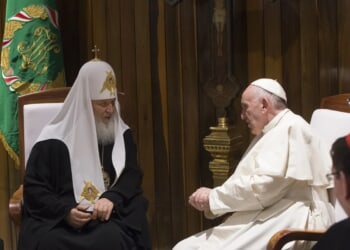
NEWS AND ANALYSIS:
The People’s Liberation Army is making progress on the use of drone swarms in combat for both weapons strikes and intelligence gathering, according to an Air Force think tank report.
Chinese military writings and Chinese media reveal the PLA is well along in developing coordinated drone attacks using large numbers of small, unmanned aircraft.
The PLA also is building hybrid drone warfare capabilities, identified in the report as manned-unmanned teaming, or MUM-T, that combines the use of drones with ground-, air- and sea-based weapons systems.
“Though neither is fully realized, the PLA’s operational thought surrounding [unmanned aerial vehicle] swarm tactics and applications is likely more mature and more likely to be deployed in a near-term conflict than MUM-T techniques,” according to the report published this week by the China Aerospace Studies Institute.
Drone warfare is a strategic element of PLA modernization that seeks to transform its forces from a human-based army into what is called “intelligentized” warfare capabilities.
The report on China’s use of drone swarms for future combat comes as the commander of the Indo-Pacific Command, Adm. Sam Paparo, said recently his forces plan to use large numbers of low-cost drones against Chinese military forces during any future PLA invasion of Taiwan.
Thousands of aerial and underwater drones will be used by American forces as an initial holding action until other warships and warplanes can be moved to the region.
Current PLA plans call for a lightning attack on the island democracy, and Adm. Paparo has called his drone defenses a “hellscape” strategy.
The Air Force report identifies three types of PLA swarm warfare approaches. They are called “goose flock warfare,” “bee swarm warfare” and “mothership warfare.”
The goose flock concept will use multifunction drone swarms that conduct a sequence of activities including reconnaissance, electronic warfare and kinetic strikes against all types of targets, producing cumulative effects on enemies.
Bee swarm warfare calls for employing decentralized, coordinated and autonomous “saturation” attacks against predetermined targets through the use of large numbers of drones in a bid to overwhelm an enemy.
For mothership warfare, the PLA plans to combine drone swarms with conventional aircraft and ships and use retrievable UAVs that will conduct attacks over larger areas against all types of targets.
PLA drone warfare capability is being built to handle multiple missions, including intelligence, surveillance and reconnaissance. PLA drones will also be used for precision-guided strikes, communications relays, electronic warfare and battlefield support and logistics.
The report identified extensive research and development of drone swarms and said some army units have conducted training with drone swarms.
Details on actual deployment of drone swarms, however, are thin, the report said.
Still, the PLA has “an extensive research and development ecosystem that is steadily developing more mature swarm technologies,” the report said.
The PLA also has studied the heavy use of small UAVs in the Russia-Ukraine war, as well as drone use in Syria and Israel.
“China’s defense industry has developed numerous prototypes and demonstrators for swarm and MUM-T technologies, including some that make extensive use of artificial intelligence,” the report said.
“There is no public evidence, however, that any of these prototypes or demonstrators have reached full operational status with line units in the PLA.”
The report concludes that development, adoption and deployment of drone warfare capability “will continue apace.”
Defense analysts John Chen and Emilie B. Stewart authored the report “PLA Concepts of UAV Swarms and Manned/Unmanned Teaming.”
Report identifies indicators of a coming Chinese attack on Taiwan
Chinese President Xi Jinping could launch an invasion of Taiwan in the next two to three years, based on an analysis of factors that indicate waiting longer would make a takeover of the island more difficult, according to a China security specialist.
Mr. Xi, who is also head of the Chinese Communist Party and its Central Military Commission, has made retaking the democratically ruled island as a core mission.
What remains unknown is whether Mr. Xi and CCP leadership will resort to military force against Taiwan — located about 100 miles off China’s southeast coast.
Mr. Xi has ordered the People’s Liberation Army to be ready for military action against Taiwan by 2027.
That date has triggered U.S. intelligence agencies to assess whether an invasion or another type of military action is coming.
In July 2022, then-CIA Director William Burns said an attack is “less the question of whether the Chinese leadership might choose some years down the road to use force to control Taiwan, but how and when they would do it.”
Gregory J. Moore, with the National Institute of Deterrence Studies, a think tank, said an analysis of a “dashboard” of 13 indicators suggests the Chinese leader could order an attack as soon as 2026 or by 2029.
“A close analysis of these 13 variables — Xi’s dashboard dial … suggests that an invasion of Taiwan is likely within the next one to three years,” Mr. Moore, a professor of government at Patrick Henry College, said in a journal article.
Eleven of the 13 key warning signs reveal that delaying military action beyond the three-year window will leave Mr. Xi and China in a weaker position and losing strength.
“In short, 11 of 13 dials on Xi’s dashboard flash warnings that time is not on his side,” Mr. Moore stated.
Two indicators suggest that waiting beyond three years will give the PLA more time to build up advanced military capabilities needed for a difficult amphibious operation and also will allow for China’s ailing economy to recover.
But the other 11 signs reveal a closing window of opportunity due to, among other factors, Taiwan’s increasing identity as non-Chinese and China’s sharp demographic decline, which is expected to lead to fewer fighting age people as years pass — making military recruiting more difficult.
Taiwan’s advanced semiconductor industry is another factor. China’s current lack of access to Taiwan’s advanced chips argues for a near-term attack.
A delays in a PLA invasion also gives the United States more time to cement ties to Taiwan, including the prospect of joint military exercises and increased armed forces interoperability between the Taiwan military and the U.S. forces
Another military advantage for the PLA in a near-term strike on Taiwan is the PLA’s advantage in hypersonic maneuvering missiles that can defeat U.S. and allied missile defenses.
A delay in an invasion will allow the Pentagon to close the hypersonic missile gap for both offensive and defensive systems.
Also, the currently deteriorating relationship between Washington and Beijing means the diplomatic fallout of a Taiwan attack couldn’t make matters much worse. Mr. Xi perceives the United States as increasingly hostile, and that animosity is likely to eventually translate into stronger U.S. backing for Taiwan — another argument for attacking sooner.
Finally, China may calculate that attacking sooner is preferable because of the 2024 election of pro-independence President Lai Ting-che, who is speeding up Taiwan’s drift from Beijing.
Beijing recently said taking over the island is a “sacred” CCP goal that needs to happen by 2027 for Mr. Xi to claim a fourth term in office at a major CCP congress that year.
Mr. Moore said predicting the future is impossible, but close study of the indicators “presents compelling evidence that a near-term Chinese invasion of Taiwan — within one to three years — must be considered not just possible but plausible.”
Waiting for military readiness favors a delay but the need for preparations may not override the broad set of factors.
The report “presents strong evidence that the advantages of striking sooner rather than later are significant,” Mr. Moore said.
“China faces closing windows of opportunity — both in its relative military balance with the United States and in Taiwan’s own defense preparations,” he said.
“The longer Beijing waits, the harder an invasion becomes. These pressures may ultimately outweigh any lingering doubts about the risks of acting too soon.”
The report was published this week in The Journal of Indo-Pacific Affairs, produced by the Air Force Air University Press.
House intelligence leader favors greater Havana Syndrome probe
Rep. Rick Crawford, chairman of the House Permanent Select Committee on Intelligence, said Wednesday he supports a new intelligence community investigation into brain injuries suffered by diplomatic and intelligence personnel dubbed Havana Syndrome.
Mr. Crawford said in a statement that greater efforts are needed to investigate the maladies.
Earlier this month, Director of National Intelligence Tulsi Gabbard set up a new panel called the Director’s Initiatives Group to examine issues related to intelligence agencies, including the handling of anomalous health incidents.
U.S. intelligence agencies have come under fire from victims of the incidents after analysts concluded the cause was very likely not the result of attacks by hostile nations. The analysts blamed mental or environmental causes.
“I have said before, the Biden administration’s IC was wrong in its previous intelligence assessment, and we are working to set the record straight,” the Arkansas Republican said.
Mr. Crawford has said he believes Havana Syndrome is the result of some type of foreign attack.
• Contact Bill Gertz on X @BillGertz.


![NYC Tourist Helicopter Falls into Hudson River, Siemens Executive and Family Among Those Killed [WATCH]](https://www.right2024.com/wp-content/uploads/2025/04/NYC-Tourist-Helicopter-Falls-into-Hudson-River-Siemens-Executive-and-350x250.jpg)






![Red Sox Fan Makes the ‘Catch of the Day’ with Unconventional ‘Glove’ [WATCH]](https://www.right2024.com/wp-content/uploads/2025/04/Red-Sox-Fan-Makes-the-‘Catch-of-the-Day-with-350x250.jpg)
![Green Day’s Cringe Trump Diss Ends in Fire and Evacuation [WATCH]](https://www.right2024.com/wp-content/uploads/2025/04/Green-Days-Cringe-Trump-Diss-Ends-in-Fire-and-Evacuation-350x250.jpg)






